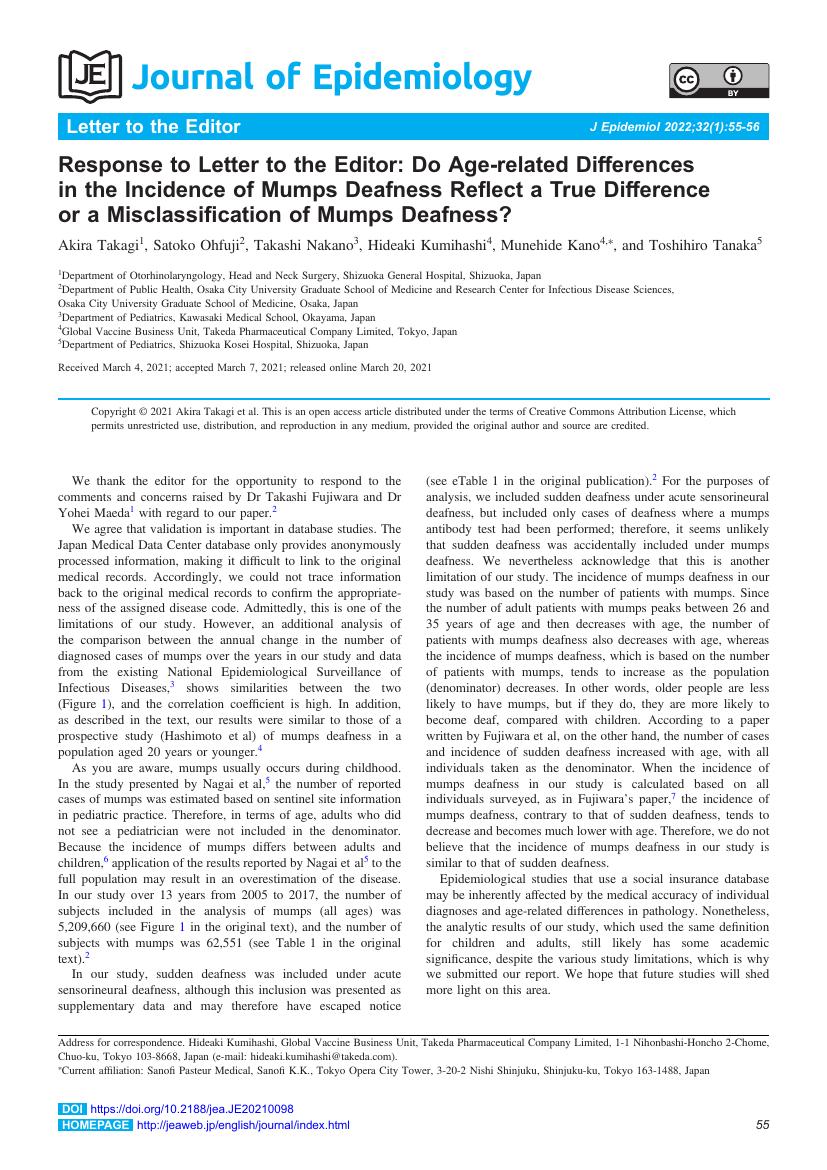2 0 0 0 OA Incidence of Mumps Deafness in Japan, 2005–2017: Analysis of Japanese Insurance Claims Database
- 著者
- Akira Takagi Satoko Ohfuji Takashi Nakano Hideaki Kumihashi Munehide Kano Toshihiro Tanaka
- 出版者
- Japan Epidemiological Association
- 雑誌
- Journal of Epidemiology (ISSN:09175040)
- 巻号頁・発行日
- vol.32, no.1, pp.21-26, 2022-01-05 (Released:2022-01-05)
- 参考文献数
- 17
- 被引用文献数
- 3 9
Background: Mumps deafness causes serious problems, and incidence data are needed to identify its disease burden. However, such data are limited, and the reported incidence is highly variable. Nationwide studies in Japan with a large age range are lacking.Methods: This was a retrospective observational investigation of the 2005–2017 mumps burden using employment-based health insurance claims data. Data were analyzed for 5,190,326 people aged 0–64 years to estimate the incidence of mumps deafness.Results: Of 68,112 patients with mumps (36,423 males; 31,689 females), 102 (48 males; 54 females) developed mumps deafness—an incidence of 15.0 per 10,000 patients (1 in 668 patients). Fifty-four (52.9%) patients had mumps deafness in childhood (0–15 years), and 48 (47.1%) had mumps deafness in adolescence and adulthood (16–64 years); most cases occurred in childhood, the peak period for mumps onset. The incidence of mumps deafness per 10,000 patients was 73.6 in adolescence and adulthood, 8.4 times higher than the incidence of 8.8 in childhood (P < 0.001). In childhood, the incidence of mumps deafness was 7.2 times higher among 6–15-year-olds (13.8; 95% CI, 10.2–18.2) than among 0–5-year-olds (1.9; 95% CI, 0.6–4.5), and this difference was statistically significant (P < 0.001). No sex difference was observed.Conclusions: The incidence of mumps deafness per 10,000 patients aged 0–64 years was 15.0 (1 in 668 patients). A secondary risk of deafness following mumps virus infection was identified not only for children, but also for adolescents and adults.
- 著者
- Akira Takagi Satoko Ohfuji Takashi Nakano Hideaki Kumihashi Munehide Kano Toshihiro Tanaka
- 出版者
- Japan Epidemiological Association
- 雑誌
- Journal of Epidemiology (ISSN:09175040)
- 巻号頁・発行日
- vol.32, no.1, pp.55-56, 2022-01-05 (Released:2022-01-05)
- 参考文献数
- 7
1 0 0 0 OA Incidence of Mumps Deafness in Japan, 2005–2017: Analysis of Japanese Insurance Claims Database
- 著者
- Akira Takagi Satoko Ohfuji Takashi Nakano Hideaki Kumihashi Munehide Kano Toshihiro Tanaka
- 出版者
- Japan Epidemiological Association
- 雑誌
- Journal of Epidemiology (ISSN:09175040)
- 巻号頁・発行日
- pp.JE20200233, (Released:2020-10-24)
- 参考文献数
- 17
- 被引用文献数
- 9
Background: Mumps deafness causes serious problems, and incidence data are needed to identify its disease burden. However, such data are limited, and the reported incidence is highly variable. Nationwide studies in Japan with a large age range are lacking.Methods: This was a retrospective observational investigation of the 2005–2017 mumps burden using employment-based health insurance claims data. Data were analyzed for 5,190,326 people aged 0–64 years to estimate the incidence of mumps deafness.Results: Of 68,112 patients with mumps (36,423 males; 31,689 females), 102 (48 males; 54 females) developed mumps deafness—an incidence of 15.0 per 10,000 patients (1 in 668 patients). Fifty-four (52.9%) patients had mumps deafness in childhood (0–15 years), and 48 (47.1%) had mumps deafness in adolescence and adulthood (16–64 years); most cases occurred in childhood, the peak period for mumps onset. The incidence of mumps deafness per 10,000 patients was 73.6 in adolescence and adulthood, 8.4 times higher than the incidence of 8.8 in childhood (P < 0.001). In childhood, the incidence of mumps deafness was 7.2 times higher among 6–15-year-olds (13.8 [95% CI, 10.2-18.2]) than among 0–5-year-olds (1.9 [95% CI, 0.6-4.5]), and this difference was statistically significant (P < 0.001). No sex difference was observed.Conclusions: The incidence of mumps deafness per 10,000 patients aged 0–64 years was 15.0 (1 in 668 patients). A secondary risk of deafness following mumps virus infection was identified not only for children, but also for adolescents and adults.
- 著者
- Yukiko Takao Yoshiyuki Miyazaki Fumitake Onishi Hideaki Kumihashi Yasuyuki Gomi Toyokazu Ishikawa Yoshinobu Okuno Yasuko Mori Hideo Asada Koichi Yamanishi Hiroyasu Iso
- 出版者
- 日本疫学会
- 雑誌
- Journal of Epidemiology (ISSN:09175040)
- 巻号頁・発行日
- vol.22, no.2, pp.167-174, 2012-03-05 (Released:2012-03-05)
- 参考文献数
- 33
- 被引用文献数
- 2 20
Background: The incidence and risk factors for herpes zoster have been studied in cross-sectional and cohort studies, although most such studies have been conducted in Western countries. Evidence from Asian populations is limited, and no cohort study has been conducted in Asia. We are conducting a 3-year prospective cohort study in Shozu County in Kagawa Prefecture, Japan to determine the incidence and predictive and immunologic factors for herpes zoster among Japanese.Methods: The participants are followed for 3 years, and a telephone survey is conducted every 4 weeks. The participants were assigned to 1 of 3 studies. Participants in study A gave information on past history of herpes zoster and completed health questionnaires. Study B participants additionally underwent varicella-zoster virus (VZV) skin testing, and study C participants additionally underwent blood testing. If the participants develop herpes zoster, we evaluate clinical symptoms, measure cell-mediated immunity and humoral immunity using venous blood sampling, photograph skin areas with rash, conduct virus identification testing by polymerase chain reaction (PCR) and virus isolation from crust sampling, and evaluate postherpetic pain.Results: We recruited 12 522 participants aged 50 years or older in Shozu County from December 2009 through November 2010. The participation rate was 65.7% of the target population.Conclusions: The present study is likely to provide valuable data on the incidence and predictive and immunologic factors for herpes zoster in a defined community-based population of Japanese.
